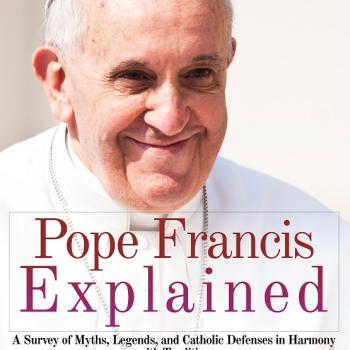
The following exchanges took place on a public discussion combox for The Catholic World Report, between 28 February and 2 March 2020. Words of Dr. Robert Fastiggi will be in black; those of Fr. Peter Morello, PhD in blue, of Leslie, in green, and of Brian Killian in brown.
*****
Yes, we must be concerned about violations of the first and sixth commandments, but we must also be concerned about violations of the eighth commandment. It has never been proven that idolatry took place in the Vatican Gardens on October 4, 2019. Those who claim that it did need to re-read what the Catechism of the Catholic Church teaches about rash judgment (nos. 2477-2478). St. John Paul II, in a homily given in Cochabamba, Bolivia on May 11, 1988, referred to “pachamama” as the ancestral name given to creation and the earth, which are the work of God and a reflection of divine Providence. See no. 10 in the homily.
This article by Francisco Figueroa goes into papal perspectives on “pachamama” in more depth: The Catholic lawyer (and papal critic), Eric Giunta, provides some further insights here.
Pedro Gabriel, M.D. provides some more helpful perspectives in this article. Perhaps there could have been better communication about the meaning of the symbols used in the Vatican Garden prayer ceremony on Oct. 4, 2019. To simply label what took place as “idolatry” strikes me as rash judgment, which is forbidden by the eighth commandment.
Dr Fastiggi your defense of the Pontiff is virtuous, we should give him the benefit of the doubt when applicable. Although respectful adherence to the Roman Pontiff is not an act of faith in a person rather foremost a faithful recognition of the office [the canonical definition of that authority] instituted by Christ. Matters that are not strictly Magisterially binding are subject to reasoned assessment. You may interpret Pachamama veneration [it was called such by the Vatican] as you wish insofar as the Pope’s intent. Intent as you’re aware does not determine the morality of an act. And neither does an act necessarily determine a benign intent, which I’m inclined to believe was. Right reason however assesses the object of the act, which is veneration [worship] of an Idol.
Whether Pope Francis did not intend idolatry the act itself speaks to idolatry in similar manner that having an affair outside of marriage however well intended between both parties remains immoral. Acts that are objectively manifest as illicit remain illicit despite intent. And certainly you’re aware of the wide scandal caused among the faithful, which is also addressed by canon law and the Catechism. It’s possible to make reference to native ritual, veneration of objects as having some cultural value. It’s entirely another matter to have a ceremonial procession chanting, gesticulating gleefully, offering prayers centered on a widely known Andean goddess of the Earth up to and in front of the main altar of St Peter’s Basilica.
Dear Fr. Morello,
Thank you for your gracious note. All I can ask is that you and others read the articles to which I provided the links. You assume the wooden statues were idols, but that’s not at all certain. In the article by Eric Giunta he explains that “Pachamama” has a different meaning in the Andes than in the Amazon. In his May 11, 1988 homily in Bolivia, St. John Paul II provided a benevolent understanding of “Pachamama.” I agree that a good intention does not change the status of an objectively immoral act like adultery. The question, though, is whether what took place in the Vatican Gardens or in the processions you mention were actual acts of idolatry. I think there are far more benevolent explanations available. Oremus pro invicem.
***
I’ve learned to trust my own understanding of what the Holy Father says and does. I actually believe some of the confusion is generated by certain people and groups who take an overly critical view of Pope Francis.
***
St. John Paul II, in a homily given in Cochabamba, Bolivia on May 11, 1988, referred to “pachamama” as the ancestral name given to creation and the earth, which are the work of God and a reflection of divine Providence.
Mmmm. Can you provide me with video from when Pope John Paul II gave that homily that compares to this [?]
Did the Italian Bishops’ Conference publish a prayer to Pachamama in 1988? (the bishops’s site has pulled the page by now).
Also, all kinds of pagan religions had names given to creation and the earth, which are the work of God and a reflection of divine Providence. If that’s the best they knew – or know – that’s one thing. It doesn’t follow that Catholics, or even Christians in general, should be participating in ceremonies involving those things.
From one of your links: “I cannot find any scholarly or other documentation that “Pachamama,” an Andean deity, is commonly worshiped by non-Christians in the Amazon.”
Oh, yes? Then why was there a Pachamama statue (and I remind you that Pope Francis called it that) at something that was related to the Pan-Amazonic synod? And my, but Mr. Giunta is snide.
From Dr. Gabriel’s article:
Earlier today, it has been reported on Twitter that Ruffini issued a “definite answer”:
No prostrations or rituals were performed. We must all be rigorous in telling things that have happened in front of the cameras.
No? I just watched the video. Kneeling and then lowering one’s forehead to the ground in a circle around the statue is prostration.
From the same link, Brother Afonso Murad said, “Among them, there were three female silhouettes of an indigenous pregnant woman that symbolized the Earth that takes care of us, and also the indigenous peoples. … Therefore it was simply a religious symbol among many that are present in that church for those who want to see it. Therefore, this act was an act of violence, of disrespect and therefore cannot be approved by any of us. Would you like it if someone went to your church and took any of your religious symbols, be it a candle, or a cloth, would you like it? Of course not.”
Actually, if somebody put a statue that represented, say, Terra (the Roman name for Gaia) and the indigenous peoples of Italy, or Greece, or anywhere else in the world, in my church, I would most definitely salute anybody who took it out of the church. I wouldn’t want it thrown in the river, however; I’d want it burnt.
Someone else said it was “Our Lady of the Amazon.” How very exceedingly odd that they can’t even get their stories straight.
“In other words, at least some of the natives look to this figure and attribute a Marian connotation to it.”
And some of them, in fact possibly many of them, don’t.
“And we know that at least one of those natives was the woman who presided over the St. Francis Day activity in the Vatican Gardens.”
And that brings me to another question: Why was a woman presiding over the “activity?”
“For me, I cannot imagine how Monday’s act of disrespect for indigenous culture by people who proclaim themselves to be the mouthpieces of true Catholicism will open the hearts of the natives who brought that image as a symbol of their values”
Mmmmm, yeah, how dare St. Boniface have cut down that tree? So disrespectful of indigenous culture, of an image that was a symbol of their values.
“Vatican spokesman Matteo Bruni said the pope used the word as a means to identify the statues because that is the way they have become known in the Italian media and not as a reference to the goddess.”
Yet another example of the necessity of explaining, or explaining away, something that has been said.
Dear Leslie,
The burden of proof is on you to prove that idolatry took place. That you have not done. You assume what you need to prove.
The burden of proof is on you to prove that I said idolatry took place. That you have not done. You assume what you need to prove.
Tell me, will you at a very minimum admit that kneeling around a representation of the planet earth (which is what that painted cloth appears to be) and a statue that very likely (I’m being generous and not saying “almost certainly”) represents an earth goddess, bringing offerings, and bowing to the ground in worship, are actions very open to interpretation as idolatry?
I do not speak whatever language it is in which they were chanting or praying. Can you provide me with a translation?
Dear Leslie,
Thank you for your follow-up comments. Here is the Vatican Press Release from Oct. 1, 2019 explaining the prayer service that would take place in the Vatican Gardens on October 4.
The ceremony was profoundly Catholic. The representative of REPAM recited a prayer of consecration of the Amazon Synod to St. Francis of Assisi. Cardinal Turkson (in Italian) spoke of the shared commitment of Pope Francis and Patriarch Bartholomew to the care of the earth, our common home. Cardinal Humes (speaking in Portuguese) highlighted the importance of St. Francis of Assisi as the patron saint of ecology, and he then recited the Canticle of the Creatures by St. Francis of Assisi in Italian. A religious sister gave some reflections in Spanish, and she recited a passage from the prophet, Jeremiah. Another speaker (in Italian) referred to the Canticle of Creatures of St. Francis of Assisi and then recited Psalm 148, which bears a resemblance to St. Francis’s Canticle.
There is an important explanation around 6:13 into the video of the ceremony. A Franciscan friar (in Italian) explains that the instruments displayed on the circular mat are symbols of water, earth, seeds, and martyrs. He then switches into Spanish. The brief bowing to the symbols displayed on the mat can easily be understood as a gesture of prayer asking God to bless the upcoming synod. I could not make out the words of the song they were singing. Those who claim this was a pagan incantation, though, need to provide evidence (which they have not done). When the representatives from the Amazon bestow symbols from the Amazon to Pope Francis they make the sign of the cross. One of the women bows before the Holy Father. (Was she worshipping him as an idol?). The woman who presents the wooden statue to Pope Francis refers to the image as “Our Lady of the Amazon” as Dr. Pedro Gabriel explains.
A large part of the ceremony was bringing portions of soil to the tree being planted with accompanying explanations of what these portions of the earth represent (all of them profoundly Christian). The ceremony ends with the singing of the Canticle of the Creatures by St. Francis of Assisi and the Pope Francis reciting the Lord’s Prayer in Spanish. This was a deeply Catholic prayer service. The claim that a pagan ceremony was somehow inserted into such a Catholic prayer service strains credulity.
The postings above by Brian Killian are well worth reading. Bows and prostrations can take on different meanings. St. John Paul II was known to bow down and kiss the earth when he first set foot in a country on an apostolic visit. Was he worshipping the earth? To accuse the Pope and the Holy See of sponsoring or endorsing a pagan ceremony is so serious that those who make such an accusation better provide evidence. The only “evidence” I’ve seen so far is grounded in subjective impressions motivated it seems by distrust and hostility towards Pope Francis. Referring to what took place on October 4, 2019 as idol worship without any real evidence strikes me as a grave violation of justice, charity, and the eighth commandment. I am sorry to be so blunt, but I believe it’s important to warn people of the serious spiritual implications of such unfounded and grave accusations against the Roman Pontiff.
Thank you for the information.
You didn’t answer this question: “Tell me, will you at a very minimum admit that kneeling around a representation of the planet earth (which is what that painted cloth appears to be) and a statue that very likely (I’m being generous and not saying “almost certainly”) represents an earth goddess, bringing offerings, and bowing to the ground in worship, are actions very open to interpretation as idolatry?”
At best, I consider the whole thing to have been inadvisable.
To accuse the Pope and the Holy See of sponsoring or endorsing a pagan ceremony is so serious that those who make such an accusation better provide evidence.
Or one could be considering them to be innocent dupes.
The only “evidence” I’ve seen so far is grounded in subjective impressions motivated it seems by distrust and hostility towards Pope Francis.
And what would be the grounds for people to have distrust towards Pope Francis?
Dear Dr Fastiggi as you honor the Roman Pontiff others also have deep respect for him and cherish the Chair of Peter instituted by Christ. We also recognize the purview of that sacred authority and its limits. “When the Pope thinks it is God who is thinking in him” (Louis Veuillot). Veuillot a staunch Catholic believed anything said, likely also done by a Roman Pontiff was consequently sacred. That of course as I’m confident you agree is untrue. It’s not necessary to recount history on that matter with you because the evidence of that untruth is clear.
Nevertheless there is a tendency for some of us today to follow what 18th century French journalist Louis Veuillot professed, a form of Ultramontanism that defends anything Pope Francis says or does as inspired by God. For those of us who question the events at the Vatican discussed here you find it “important to warn people of the serious spiritual implications of such unfounded and grave accusations against the Roman Pontiff”. Perhaps some remarks made were untoward. Though not all spoke disrespectfully. Though most were concerned, even distressed by events. I would only ask that you consider that there may be justification for concern.
***
You’re [i.e., Fr. Morello] begging the question. How do you know the “object of the act” was the veneration of an idol? There is no such thing as an intrinsic act of idolatry just as there’s no physical object that is intrinsically an idol. A physical object is not an idol unless the object is believed to be a god or a representation of a god. An action is not idolatrous unless it’s intended to be the veneration of an idol. In both cases, one can’t say what is an idol or what is an act of idolatry until and unless one knows what the belief is about the supposed idol and what the intention is of the supposed idolater. Rituals, gestures, and symbols are all intentional, the “object” is determined by what they are referring to or intending. Intent doesn’t determine the morality of an act, but the morality of a ritual act is not what is disputed. The question is not the morality of an act but what does the act mean and to what does it refer?
In itself, the statue is nothing more than a figure of a pregnant woman. It is a multivalent symbol in the Amazon, it can represent a goddess, it can represent Mother Earth, or it can represent the Virgin Mary. Bowing is also a multivalent gesture, it can mean different things depending on the intention of the person. So how do you prove that the figure is an idol and that the people were engaged in idolatry? Everything depends on knowing what the beliefs and the intentions of the participants were. You must provide evidence of a belief that the figure was a god figure, which would indicate an intention to venerate an idol. So do you have that evidence?
These weren’t pagans that someone found in the middle of the jungle and shipped to Rome to demonstrate their ceremonies, they were Catholics. The woman on the video referred to the figure in her hands as “Our Lady of the Amazon”. That in itself is a refutation of the idolatry theory. We also know that these figures have been used to represent the general notion of Mother Earth. Again, that refutes the idolatry theory. What evidence do you have that anyone at that ceremony or anyone involved with REPAM had a belief that the figure represented a pre-Christian divinized goddess?
On the contrary, the bishop emeritus of San Cristóbal de Las Casas, Mexico relates how he asked a Bolivian indigenous person if Mother Earth (Pachamama) and Father Sun (Inti) were gods. The person replied that “those who have not received evangelization consider them gods; For those of us who have already been evangelized, they are not gods, but the best gifts of God.”
Is that distinction not good enough for you that despite their deep connection to and veneration of “Mother Earth”, that they nevertheless know that they are creations of God and not gods? The concept of mother earth is also not lacking in Christian scripture. One can find it in Job, “naked I came forth from my mother’s womb, and naked I will go back again.” One can find it in the Psalms, “My frame was not hidden from you when I was made in the secret place, when I was woven together in the depths of the earth.”
So if you want to claim that there was idol worship going on at the Vatican you need to provide evidence that demonstrates idolatrous beliefs and intentions, evidence that doesn’t beg the question, evidence that overwhelms and cancels out the evidence to the contrary that the ceremony was indeed an enculturated Christian ceremony.
Brian what an act does determines the object of the act, for example sawing a limb off a tree. You’re reverting back to the intent as if there is some indeterminate object of the act. As someone in their skepticism, actually an unwillingness to accept reality for sake of defending their position continues to say How do you know Father that the man sawing the limb off the tree intended to saw the limb off the tree? There is the internal object of the will [the intent or form] what you’re referring to, and the external object of the will that determines the object of the act [the matter or materia circa quam]. Your quotes which reference cultural interpretation do not address the fact, what the act does. Examples of religious and laity prostrating before Pachamama in the Gardens, enshrinement procession of clergy, laity chanting toting a canoe with Pachamama into Saint Peter’s Basilica up to the main altar clearly makes a definitive statement of intent. We cannot parse reality to suit our disposition.
Suppose a disciple of a syncretistic religion (that worships saints as gods together with other local gods) was in a cathedral kneeling in front of a statue of a saint or lighting a votive candle, or making some other gesture of veneration. You walk into the cathedral and see this person without knowing anything about him. How would you know, just by looking at him, if he was a Catholic venerating a saint or a syncretist worshiping a false god? You wouldn’t.
You wouldn’t be able to tell unless you asked him what he was doing (revealing his intention). There is no externally recognizable act of idolatry because idolatry is necessarily an intention, like love or virtue.
You see a politician give a homeless man twenty dollars. Was it charity or vainglory? Was he moved by pity or was he moved by a desire to look good on camera? We don’t know by observing his actions, we only know by his actual intentions. Yes, the object is indeterminate from the perspective of an outside observer.
So once again, you are going to have to do more work than merely assuming that the pregnant woman was an idol (a pagan god) and that the gestures of the people in the ceremony was idolatry. Everything we know about the ceremony, the people, their intentions, demonstrate the absurdity and the falsity of the “idolatry” hypothesis.
Most crimes require general intent, meaning that the prosecution must prove only that the accused meant to do an act prohibited by law. Whether the defendant intended the act’s result is irrelevant. Example: A state’s law defines battery as “intentional and harmful physical contact with another person.” This terminology makes battery a general intent crime. The intent element is satisfied if the defendant intends to cause harmful physical contact and actually causes it—it doesn’t matter whether the defendant actually intended to hurt or seriously injure the victim (Nolo). Nolo is an assoc of criminal defense attorneys Nolo Latin for I do not intend.
Among the very best analyses of responsibility and or lack is within the legal system reaching back to English criminal law, the Roman Codex. When meeting justice the greatest ethical minds such as Blackstone Britain Scalia US fine tune our perception of justice and responsibility. If you perform an act despite the benevolent intention [he did not intend to practice idolatry rather promote ecological concern] which I grant the Pontiff, guilt can be justly adjudicated on the basis of the consequences of the act. We must be responsible for what we do.
Related Reading
“Pachamama” [?] Statues: Marian Veneration or Blasphemous Idolatry? [11-5-19]
“Pachamama” Fiasco: Hysterical Reactionaryism, as Usual [11-8-19]
“Pachamama” Confusion: Fault of Vatican or Catholic Media? [11-12-19]
Anti-“Pachamama” Doc: “Usual Suspect” Reactionaries Sign [11-14-19]
Vatican II –> Alleged “Pachamama” Idolatry, Sez Fanatics [11-15-19]
Bishops Viganò & Schneider Reject Authority of Vatican II [11-22-19]
Viganò, Schneider, Pachamama, & VCII (vs. Janet E. Smith) [11-25-19]
Is “Mother Earth” a Catholic Concept (Church Fathers)? (guest post by Rosemarie Scott) [12-17-19]
“Pachamama” Redux (vs. Peter Kwasniewski & Janet Smith) [12-17-19]
Dialogue: “Pachamama” (?) Statues & Marian Iconography [12-24-19]
***
***













